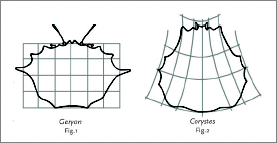
 |
|||||
| 1 -- 2 -- 3 -- 4 -- 5 -- 6 -- 7 -- 8 -- 9 -- 10 -- 11 | |||||
A Note on Misidentification
Capadotus pacitus [sic]: the name given for this species was indistinct. Could the reference have been to Calyptites? Or perhaps to Colobopsis? Either would be unlikely, as Calyptites had been assigned to an extinct sub-family of the formicidae in the past, is now almost certainly not even considered to be an ant. It is one of two fossil genera, the true taxonomic position of which remains unknown. The stronger possibility is that Colobopsis was the intended reference, but again confusion arises: Colobopsis is a sub-genre of the Genera Calomyrmex, specifically *Camponotites/Camponotus. While it is more likely that the mispronounced term was Camponotus (a dimorphic or polymorphic species of the neotropical formicinae), it is almost impossible that the observed mutated species could have been a member of this sub-genera, as Camponotites/ Camponotus is also an extinct taxon. Finally, concerning the name pacitus, pakitas, bacchitus, [sic], etc.,: there is no likely candidate in the scientific literature for this reference. (See also Zummer 1998, 'Disparities of Scale in Cinematic Biota,' where the "octopoidal bronchiata (sic)" in It Came from Beneath the Sea, 1955, is misidentified as a "member of the cephalopoda," even though it clearly has only five tentacles!).
A Note on Morphological Transformation
There is undoubtedly a complex and profound interrelation between growth and form. By understanding the concept of form as a dynamic relation, we may hope also to discern the forces which gave rise to it. If we subject Capadotus pacitus [sic] to the type of analytic morphological transformation developed by D'Arcy Wentworth Thompson in On Growth and Form, we shall obtain a picture of the radicality of such extreme transformations, in this case of gigantism, brought about by the introduction of nuclear radiation into a colony of formicidae. We will employ a representative of a sub-genre of the Genera Calomyrmex, specifically Camponotites/ Camponotus. Thompson developed a series of grid-coordinate transforms with which to study comparative morphology. These transforms suggest that various factors (environmental, behavioral, and induced) produce significant variance in a given base-species such that, over time, new species evolve.The following is an example of Thompson's model based upon the carapaces two crabs, Geryon and Corystes:
